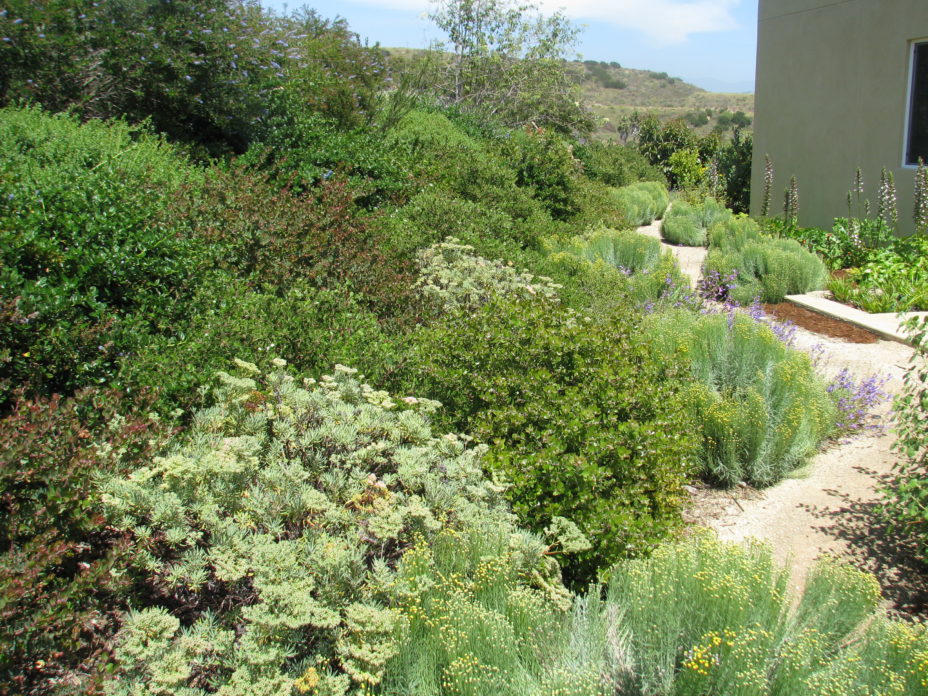Setting Up and Maintaining a Native Garden (Part Two)
Last month I gave you a synopsis of Greg Rubin’s basic explanation of the ecology of a native garden. The remainder of Rubin’s talk dealt with how to keep your garden looking healthy and vigorous all year. Rubin thinks 75 percent of your landscape should be ever green. Manzanita, Penstemon, as well as citrus and desert olive trees with their multiple trunks and height of 12 to 15 feet are examples of non-deciduous plants that will accomplish this in your garden. Forest Sierra is another evergreen for your garden.
Greg says, “Any landscape style is possible with natives.” The type of plants, their layout, and the hardscape will define your landscape, be it formal, contemporary, Mediterranean, Southwestern or even Japanese. It is essential to know what plants are available and how to use them. For example, if you want a Japanese garden, consider the box elder, which resembles the Japanese maple. (I have killed many Japanese maples.) Our native pines like shore and bishop pines also do well. Carpinteria manzanita is another choice. For the Japanese garden, shape is of paramount importance as well as scale and texture. For other garden styles, many more native choices exist.
To prepare your native garden, first clean and remove the old landscape including undesirable plants and weeds, including roots if possible. If you have lawn, Greg suggests cutting the sod two inches below the surface and “create a compost pile for the old turf.” Eliminate any hardscape and materials you will not be using from paths to plants to landscape fabric and gravel. Rubin added this includes removing “gnomes and pink flamingoes.”
The next step is to do a rough grading. Now you add pathways, rocks, boulders, walls and then your irrigation system. Rubin has many ideas about irrigation. If you have an existing drip system and need to find a better way to change to overhead watering for drought tolerant native species, change the emitters to micro-sprays.
When you are ready to plant, buy plants in one or at most five-gallon containers. In a year, not only will these small plants be impossible to tell that they were not planted from a 15-gallon container, they also will be better established. When you plant, remember that plants are like cookie dough on a baking sheet. They get bigger. Plan for their eventual size and space them accordingly.
Rubin advocates, digging a hole a half to an inch less than the native plant’s root ball’s depth. Place the plant in the hole about a half-inch higher than the soil line. It will settle. For most natives, fertilizer and soil amendments are not necessary. Do back fill with soil and tamp the soil with your feet. A temporary basin for initial watering is good on slopes, and six to 12-inch boulders are handy to place on top of the planted root ball. Most important immediatelyafter planting is to “water, water, water” using one to five gallons in clay soil and five to 30 gallons in a well-draining soil for each one-gallon plant. This gets rid of air pockets and settles the soil. If you need it, now you can put down a granular pre-emergent, an herbicide that kills grasses and weeds. This does not hurt growing plants but it does kill the shallow seed bank, which may have 10 to 100 thousand seeds per cubic foot of soil.
If you need mulch, Rubin likes putting down three to four inches of organic mulch. He uses a bi-product of shredded bark from the redwood mills. It lasts up to ten years, it emulates the “natural duff” layer, the organic litter that falls on the surface. It holds its color and adheres to steep slopes. Now is also the time to place any boulders you may want as part of your landscape design.
Then Rubin addressed maintenance. Most important is pest control; the number one pest is the Argentine ant, which “may be the single greatest threat to native landscapes.” These nasty creatures remove soil, nest in root balls, and they farm-sucking insects such as scale and aphids by placing them on the roots spreading disease while planting invasive weeds.
Rubin explained, “Sucking insect infestation is the single largest cause of death in Ceanothus, especially scale.”
Ants also plant weeds. This is how you can spot a colony. Weeds will be concentrated around ant trails and at the bases of plants instead of being distributed randomly. “Immediate, active intervention is required to save dying plants,” Rubin advises. Baits may be the best long-term strategy, but the goal is to kill the queen, not the workers. Workers live about 40 days; queens, who produce hundreds of babies each month, live more than 15 years. For every 1000 workers, there may be eight queens.
First Rubin sprays the area with Pyrethroid, a synthetic pyrethrin, which lasts longer and is more effective than the natural “to discourage ants from infiltrating from other areas.” Rubin has several combinations for non-systemic ant control. After the Pyrethrin, one might try Superthrive and Neem oil. The treatment needs to get into the colony, which may be many feet below the surface. You might look on the website for the ratios and directions for application: www.calown.com.
Another cause of destruction of our delicate native ecology is weeds. Weeds are non-native and highly invasive plants that take over. Some non-natives target and destroy mycorrhizal fungi. These fungi are needed for the health of plant roots; the fungi get sugar from the plants while maintaining the health of the roots forming a symbiotic relationship. By eliminating weeds, the native ecosystem’s health may be restored.
Rubin offers hope for us. He has plans, ideas, solutions and methods of attack. Personally, I am going after the ants.

Category: Gardening







